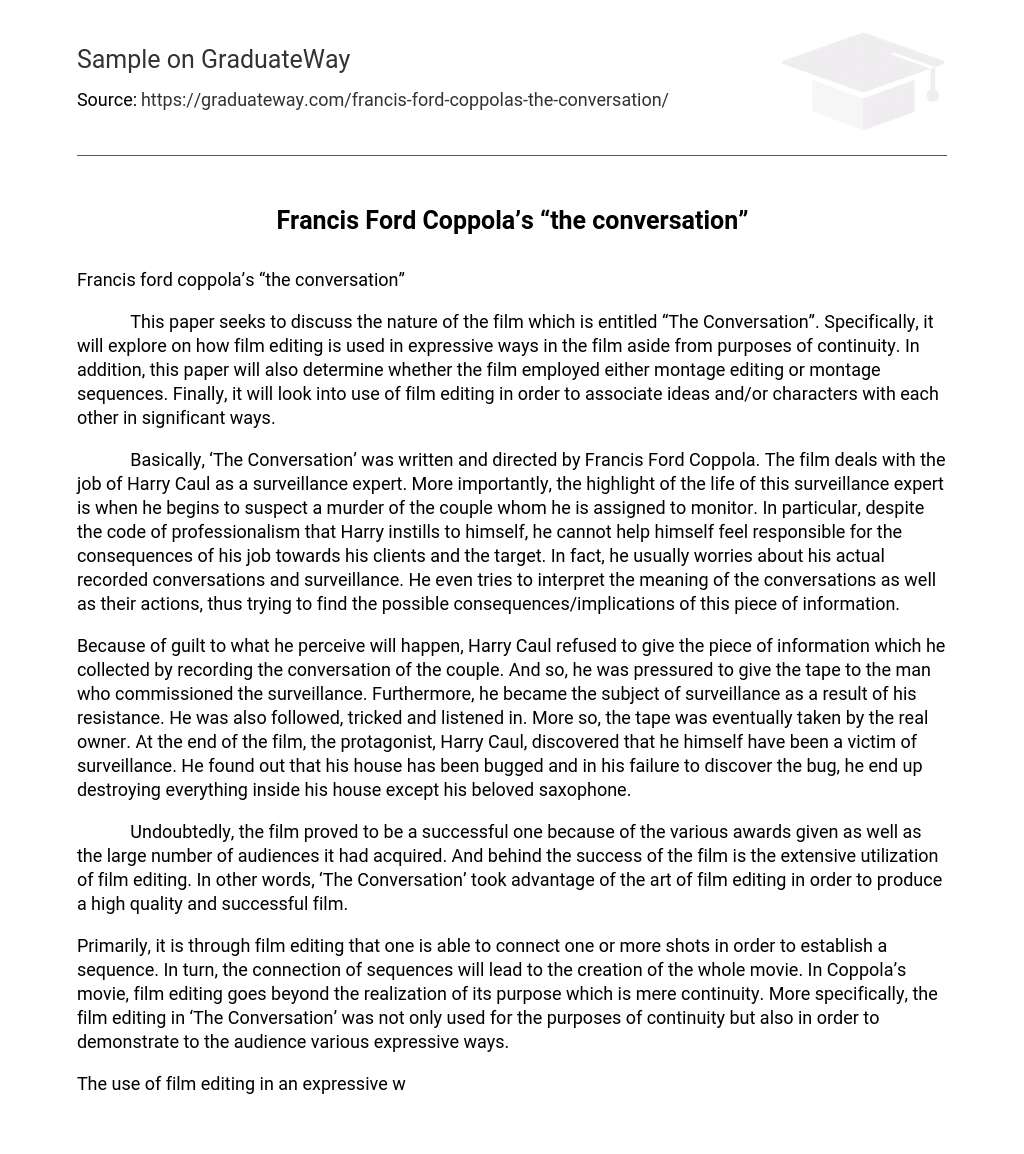This paper seeks to discuss the nature of the film which is entitled “The Conversation”. Specifically, it will explore on how film editing is used in expressive ways in the film aside from purposes of continuity. In addition, this paper will also determine whether the film employed either montage editing or montage sequences. Finally, it will look into use of film editing in order to associate ideas and/or characters with each other in significant ways.
Basically, ‘The Conversation’ was written and directed by Francis Ford Coppola. The film deals with the job of Harry Caul as a surveillance expert. More importantly, the highlight of the life of this surveillance expert is when he begins to suspect a murder of the couple whom he is assigned to monitor. In particular, despite the code of professionalism that Harry instills to himself, he cannot help himself feel responsible for the consequences of his job towards his clients and the target. In fact, he usually worries about his actual recorded conversations and surveillance. He even tries to interpret the meaning of the conversations as well as their actions, thus trying to find the possible consequences/implications of this piece of information.
Because of guilt to what he perceive will happen, Harry Caul refused to give the piece of information which he collected by recording the conversation of the couple. And so, he was pressured to give the tape to the man who commissioned the surveillance. Furthermore, he became the subject of surveillance as a result of his resistance. He was also followed, tricked and listened in. More so, the tape was eventually taken by the real owner. At the end of the film, the protagonist, Harry Caul, discovered that he himself have been a victim of surveillance. He found out that his house has been bugged and in his failure to discover the bug, he end up destroying everything inside his house except his beloved saxophone.
Undoubtedly, the film proved to be a successful one because of the various awards given as well as the large number of audiences it had acquired. And behind the success of the film is the extensive utilization of film editing. In other words, ‘The Conversation’ took advantage of the art of film editing in order to produce a high quality and successful film.
Primarily, it is through film editing that one is able to connect one or more shots in order to establish a sequence. In turn, the connection of sequences will lead to the creation of the whole movie. In Coppola’s movie, film editing goes beyond the realization of its purpose which is mere continuity. More specifically, the film editing in ‘The Conversation’ was not only used for the purposes of continuity but also in order to demonstrate to the audience various expressive ways.
The use of film editing in an expressive way is evident on the scene wherein it presents the movie as if it is surveillance and the audience or the moviegoers as the surveillance expert. The ability to give to the audience an actual scenario of surveillance can be attributed to the process of film editing. In particular, when Harry and his team were set up to record the conversation of a young couple, the outcome reveals that there few piece which are lost due to nature of the surroundings where the recording has been taken. In addition, the technical aspect of the recordings is also considered in the presentation of the film.
Moreover, it is believed that the film employed montage sequences. Specifically, the seventh art (2007) defines this concept as a segment of film that summarizes a topic or compresses a passage of time into brief symbolic or typical image. With this, the techniques used to link an image in a montage sequence are the superimpositions, dissolves, wipes and fades. In “The Conversation” the montage sequence is utilized during the scene wherein Harry had to play the tape again and again in order to catch the actual meaning of the conversation. In this scene, various clips are played and it is also accompanied by shots. These were closely studied by Caul in order to make a coherent piece out of it.
Undoubtedly, the film editing associates ideas and/or characters with each other in significant ways. Particularly, the film techniques are used to enhance the themes of surveillance. In short, it gives the audience an idea of the world of eavesdropping and surveillance. In fact, at the end of the movie, the scene of the wreckage of the house of Harry Caul is shown through a surveillance camera. This last shot implies a lot on the plot of the story.
And so, the scene wherein it is shot through a spy or surveillance camera also reflects its nature of imperfection. These imperfect ways consolidates the reality of camera stalks. In this way, the film is able to put the audience in the position of an eavesdropper. With this, one can say that the film editing of this movie became highly relevant in order to convey the true message of the story. Film makers have exploited the world of film editing in order to produce an effective movie.
REFERENCES
Wiedemann, Vinca. “Film Editing- A Hidden Art?” The Art of Film Editing. P.O.V. No. 6. Retrieved on June 27, 2007 from, http://pov.imv.au.dk/Issue_06/section_1/artc2A.html.
The Seventh Art. “Glossary of Film Terms.” Art of Cinema- Classic & Foreign. Retrieved June 27, 2007 from, http://www.geocities.com/the7thart/film-terms.html.





